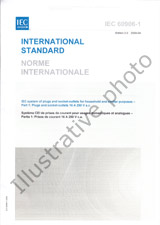We need your consent to use the individual data so that you can see information about your interests, among other things. Click "OK" to give your consent.

IEC/TR 61141-ed.1.0
Upper frequency limit of r.f. coaxial connectors
STANDARD published on 15.4.1992
The information about the standard:
Designation standards: IEC/TR 61141-ed.1.0
Publication date standards: 15.4.1992
SKU: NS-407688
The number of pages: 43
Approximate weight : 129 g (0.28 lbs)
Country: International technical standard
Category: Technical standards IEC
The category - similar standards:
Annotation of standard text IEC/TR 61141-ed.1.0 :
This technical report presents two measurement techniques for determining the first possible higher order mode (non TEM) of r.f. connector beads, connectors, and pairs of connectors. One method is a transmission measurement technique and the other is an automated reflection measurement technique. Both techniques were used to determine the resonances of different coaxial connectors. Comporte deux methodes de mesure pour determiner la frequence dapparition du premier mode non TEM des supports dielectriques des connecteurs r.f., des connecteurs et des paires de connecteurs. Lune des methodes est une technique de mesure en transmission et lautre methode est une technique de mesure automatisee en reflexion. Les deux techniques ont ete utilisees pour determiner les resonances de differents connecteurs coaxiaux. A le statut dun rapport technique.
Similar standards:
20.3.1996
11.7.2011
20.3.1996
16.2.2007
16.6.2009
29.11.2010
We recommend:
Technical standards updating
Do you want to make sure you use only the valid technical standards?
We can offer you a solution which will provide you a monthly overview concerning the updating of standards which you use.
Would you like to know more? Look at this page.



 Cookies
Cookies
